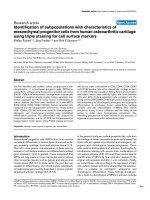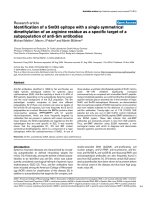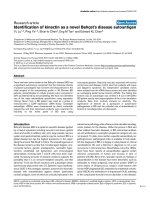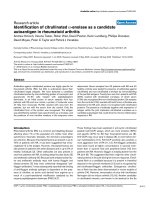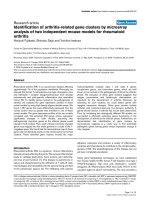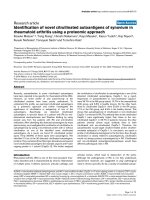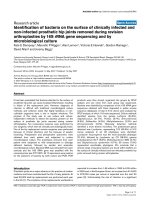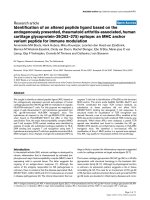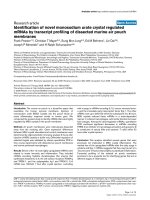Báo cáo y học: " Identification of critical residues of influenza neuraminidase in viral particle release" doc
Bạn đang xem bản rút gọn của tài liệu. Xem và tải ngay bản đầy đủ của tài liệu tại đây (2.27 MB, 14 trang )
RESEARCH Open Access
Identification of critical residues of influenza
neuraminidase in viral particle release
Jennifer R Tisoncik
1
, Ying Guo
2
, Katie S Cordero
1
, Jia Yu
3
, Jianwei Wang
4
, Youjia Cao
3
, Lijun Rong
1*
Abstract
Background: Influenza neuraminidase (NA) is essential for virus release from its host cells and it is one of the
targets for structure-based antiviral drug design.
Results: In this report, we established a pseudoviral particle release assay to study NA function, which is based on
lentiviral particles pseudotyped with influenza glycoproteins HA and NA as a surrogate system. Through an
extensive molecular analysis, we sought to characterize impo rtant residues governing NA function. We identified
five residues of NA, 234, 241, 257, 286 and 345, four of which (except 345) map away from the active site of NA
when projected onto the three-dimensional structure of avian influenza H5N1 NA, and substitutions of these
residues adversely affected the NA-mediated viral particle release, suggesting that these residues are critical for NA
enzymatic activity.
Conclusion: Through extensive chimeric and mutational analyses, we have identified several residues, which map
away from the active site and are critical for NA function. These findings provide new insights into NA-mediated
pseudoviral particle release and may have important implications in drug design and therapeutics against influenza
infection.
Background
Influenza virus causes acute respiratory infections result-
ing in an estimated 300,000 deaths worldwide each year,
of which approximately 36,000 deaths occur in the Uni-
ted States alo ne. Equally co ncerning is the emergence of
new viral strains in the human population, including the
ongoing H5N1 epizootic and swine-origin H1N1 pan-
demic [1-8]. While influenza vaccines are available, they
must be reformulated annually to control for antigenic
drift and shift of t he two major envelope glycoproteins,
hemagglutinin (HA) and neuraminidase (NA). HA binds
N-acetyl neuraminic acid (Neu5Ac) mediating virus
entry, whereas NA cataly zes Neu5Ac receptor removal
facilitating viral particle release. The abundance of
Neu5Ac on the cellular surface can impede influenza
egress making NA critical for sustained virus infection.
NA is one example where an enveloped virus has
evolved a mechanism to promote influenza virus release,
making optimal influenza virus spread and infection
[9,10].
Several other roles have been proposed for NA includ-
ing (1) clearance of ‘decoy’ receptors within the respira-
tory mucin [11], (2) reduction of viral superinfection
[12], and (3) enhancement of viral infectivity [13,14].
NA may also enhance viral infectivity by sequestering
plasminogen to facilitate activation of HA; however, th is
function may be virus specific as a recent study invol-
ving the 1918 NA does not support this notion [13-15].
It is interesting to note that, in the absence of efficient
NA activity, p rogeny virions aggregate at the cell sur-
face; however, a release-competent mutant lacking the
NA active site was the result of decreased HA binding
to Neu5Ac receptors. Thus, there appears to exist a bal-
ance of NA and HA activities in orchestrating viral par-
ticle release [16-18].
NA exists as a tetramer of identical subunits, each
monomer containing an active site that is highly con-
served across all influenza A and B viruses [19]. In addi-
tion to its enzymatic activity, NA has important
modifications that have been shown to influence viral
infectivity and possibly glycoprotein function [20].
* Correspondence:
1
Department of Microbiology and Immunology, University of Illinois at
Chicago, Chicago, IL 60612, USA
Full list of author information is available at the end of the article
Tisoncik et al. Virology Journal 2011, 8:14
/>© 2011 Tisoncik et al; licensee BioMed Central Ltd. This is an Open Access article distributed under the terms of the Creative Commons
Attribution License ( which permits unrestricted use, distribution, and reproduction in
any medium, provided the original work is properly cited.
For instance, loss of a glycan at position 146 is known
to induce neur ovir ulence in mice [13,21]. The NA stalk
length has also been demonstrated to be important for
enhanced pathogenicity of H5N1 virus [22,23 ]. Outside
of the well characterized active site, few have sought to
identify and define important residues of NA. Since NA
is one of the two major antigenic gly coproteins of influ-
enza virus, and it is a good target of drug therapeutics,
we sought to further charac terize the role of NA in this
study. Through extensive chimeric and mutational ana-
lyses, we have identified several residues, which map
away f rom the active site and are critical for NA func-
tion in viral particle release. These findings provide new
insights into NA-mediated pseudoviral particle release
and may have important implications in drug design
and therapeutics against influenza infection.
Results
Characterization of influenza NA using HIV/HA
pseudotype particles
Reporter-based HIV/HA pseudotyped viruses were gen-
erated by co-transfection of HA and env-deficient HIV-1
plasmids into 293T producer cells [24]. The human
293T and A549 target cells were challenged with the
producer cell culture supernatants collected 48 h post-
transfection and transduction determined by luciferase
activity in the target cells. Addition of soluble NA to the
culture medium during pseudovirion production
enhanced HIV/HA transduction (Figure 1A). Co-trans-
fection of NA from mouse-adapt ed human virus (PR8),
henceforth referred to as NA
H
,withtheHAandHIV
plasmids resulte d in greater transduction efficiency, 1.7
×10
7
and 6.8 × 10
6
RLU for 293T and A549 cells,
respectively. In contrast, co-transfection of NA from an
avian H5N1 virus (NA
A
) resulted in luciferase levels
only slightly higher than the background level, 1.3 × 10
3
and 1.3 × 10
2
RLU for 293T and A549 cells, respectively
(Figure 1A).
A hemagglutination assay was used to further explore
the discrepancy between NA
H
and NA
A
-mediated pseu-
dovirus production. As shown in Figure 1B, pseudovir-
ions produced in the presence of NA
H
resulted in a
hemagglutination titer of 32 HA units/ml, while expres-
sion of NA
A
resulted in no hemagglutination, similar to
the PBS control. The supernatants derived from co-
transfections with HIV vect or and NA
H
alone, or with
HIV vector, NA
H
and VSV-G, the glycoprotein of vesi-
cular stomatitis virus, resulted in no hemagglutination
(results not shown). These results correlate with the
luciferase data, further suggesting that NA
A
is deficient
in mediating pseudoviri on release from the 293T produ-
cer cell surface. To determine if the defect was related
to its enzyme activity, NA catalysis of fluorogenic sub-
strate (4-MUNANA) was measured. Compared to NA
H
,
Figure 1 Characterization of HIV/HA pseudoviral particle release
mediated by NA
A
and NA
H
. A, relative infectivity of the pseudovirions
determined by luciferase activity (relative light units, RLUs) from
infected 293T and A549 target cells. Pseudovirions generated in the
absence of NA represent background luciferase levels. As a positive
control, HA and HIV plasmids were first introduced into 293T producer
cells and the transfected cells were then treated with a commercial
neuraminidase twice during pseudovirion production (+bNA).
Experiments were performed in triplicates and repeated several times.
Error bars indicate standard deviations. B, hemagglutination activity
from titrated NA
A
and NA
H
pseudovirion populations mixed with
chicken red blood cells. PBS serves as a negative control. C,
neuraminidase activity of NA
A
and NA
H
proteins measured by the
release of fluorogenic substrate 4-MUNANA (arbitrary units).
Experiments were performed in triplicates and repeated several times,
and error bars indicate standard deviations.
Tisoncik et al. Virology Journal 2011, 8:14
/>Page 2 of 14
the avian H5N1 NA appears to be defective in its enzy-
matic activity (Figure 1C). This may be the result of
defective viral genes despite NA
A
being derived from an
avian H5N1 virus, or through PCR i ntroduced muta-
tions or both. Nevertheless, we reasoned this defecti ve
NA clone could allow us to identify critical residues of
NA which had not been identified previously.
Functional analysis of NA
H
/NA
A
chimeric constructs
Comparison of NA
A
and NA
H
primary sequences
revealed 83% amino acid identity with a total of 81
amino acid differences (Figure 2A). All the residues pre-
viously identified to be important for NA function are
identical for these genes with the exception of position
119. Thus, additional residues of NA likely play an
important role in NA activity. To delineate the region(s)
critical for NA-mediated pseudovirion release, a panel of
six c himeric NA constructs was generated and charac-
terized in the luciferase assay (Figure 2B). Chimeric pro-
tein NA
C
(NA
A
176-230) behaved like parental NA
H
resulting in 1.6 × 10
7
RLU (Figure 2B). Additionally,
hemagglutination and NA enzy me activity of NA
C
(NA
A
176-230) was comparable to NA
H
and consistent with
the luciferase data (Table 1). Within this region, aa 176-
230, there are five variable residues between the two
NAs (Figure 2B), an d therefore the dif ferences in this
region are not important for NA activity. NA chimeric
constructs NA
C
(NA
A
1-230) and NA
C
(NA
A
88-230)
displayed reduced luciferase levels and enzyme activity,
as well as a complete loss of hemagglutination (Figure
2B, and Table 1). Similarly, chimeric proteins NA
C
(NA
A
226-301), NA
C
(NA
A
226-362) and NA
C
(NA
A
226-470) all resulted in a complete loss of NA functi on.
We conclu de that variations in the N-terminus of NA
A
,
aa 88-176, and the C-terminal portion aa226-301 contri-
bute toward the defective NA
H
phenotype (Figure 2B,
Table 1).
To identify the critical residue(s) for NA function, we
took a gain-of-function approach and systematically sub-
stituted the variable residues within aa regions 88-176
(Table 1) and 226-301 of NA
C
(NA
A
88-230) and NA
C
(NA
A
226-301), respectively (Figure 3A and Table 1).
For example, tyrosine 234 in NA
C
(NA
A
226-301) was
substituted to an asparagine (NA
C
Y234N), the existing
NA
H
residue corresponding at this position. For NA
C
(NA
A
226-301), a total of ten, either single or combined,
substitutions were generated (Figure 3A). Three substi-
tutions intro duced within NA
C
(NA
A
226-301), Y234N,
M257I, and E286K, resulted in increased luciferase activ-
ity, hemagglutination and NA enzyme activity, as com-
pared to NA
C
(NA
A
226-301) (Figure 3B-D). Y234N
gave 32 HA units/ml, M257I resulted in 8 HA units/ml
and HA acti vity for E286K was observed with the undi-
luted (Und) sample (Figure 3C). These results were
generally in agreement with the enzymatic data. How-
ever, we did not observe a strong correlation between
the magnitude of th e HA and the magnitude of th e
infectivity as measured by the luciferase assay. For
example, mutant Y23 4N displayed higher HA activity
than E286K (32 vs undiluted), but it gave a lower level
of infectivity than that of E286 (also see Table 1). The
nature of this discrepancy needs to be further examined
in the future.
The NA
C
(NA
A
226-301) constructs with Y234N,
M257I, and E286K substitutions resulted in increased
levels of NA activity (Figure 3D). Taken together, these
results indicate that N234, I257, and K 286 of NA
H
are
critical for NA activity and hence function in pseudo-
viral partic le release. Using the same approach, we also
demonstrated a critical role of E119 within NA
C
(NA
A
88-230) for enzyme activity (Table 1).
To further examine the potential role of these resi-
dues of NA, N234Y, I257M, and K286E substitutions,
single or combined, w ere introduced int o NA
H
.The
single NA
H
substitutions marginally effected NA func-
tion. NA
H
double substitutio n mutants, N234Y/I257M,
N234Y/K286E and I257M/K286E, completely abol-
ished NA activity ( Figure 4A-C, and Table 1). Interest-
ingly, NA
H
triple sub stitution mutant result ed in a
revertant phenotype. Its enzymatic activity was com-
parable to NA
H
, and it displayed restored luciferase
levels and partially restored hemagglutination (Figure
4andTable1).
All NA m utants were expressed in the producer cells.
NA
H
N234Y and all three double substitution mutants
migrated faster than NA
H
on the SDS-PAGE gel (Figure
4D, left panel). the double substitution NA mutants
were not expressed on pseudoviral particles (Figure 4D,
right panel). The triple NA mutant showed a similar
migration pattern to NA
H
and it was expressed on pseu-
dovirions (Figure 4D, right panel). These data correlated
with the NA
H
triple mutant restored activity.
Identification of critical residues for NA function
An NA
A
variant derived from the A/chicken/Henan/
2004 (H5N1) mRNA, henceforth referred to as NA
A*
,
was generated and displayed an intermediate phenotype
in NA function. NA
A*
resulted in a hemagglutination
titer of 8 HA units/ml and enhanced enzyme activity
compared to NA
A
(Figure 5B, Table 1). Sequence align-
ment indicated that NA
A*
contains six amino acid differ-
ences from NA
A
. Isoleucine at position 8 of NA
A*
is
located in the transmembrane domain, and differs from
Thr8 of NA
A
. The remaining five NA
A*
residues, E119,
N234, M241, G248 and G345, which are conserved with
NA
H
at the corresponding positions, but differ from
that of NA
A
(V119, Y234, R241, W248 and R345) are
located in the ectodomain of the protein.
Tisoncik et al. Virology Journal 2011, 8:14
/>Page 3 of 14
To examine the potential roles of these five residues,
we first took a gain-of-function approach to determine
which amino acid substitutions were required to restore
NA
A
function. Since NA
H
substitution mutant G248W
was comparable to NA
H
(see Table 1), we focused on the
following residues of NA
A
, V119, Y234, R241 and R345.
As shown in Figure 6, all four substitutions in combina-
tion were required to restore NA
A
to a level comparable
to NA
A*
. These results demonstrated that these four resi-
dues are critical in maintaining NA activity.
Figure 2 Alignment of NA
A
and NA
H
amino acid sequences and schematic of NA constructs. A, amino acid sequence alignment of full-
length NA
A
and NA
H
proteins. Residue differences are shaded and deletions in the NA
H
linear sequence are denoted by (-) symbol. B, schematic
of full-length NA
A
and NA
H
proteins and chimeric NA protein panel (NA
C
). NA
H
sequence is colored red and NA
A
sequence is colored yellow.
The NA
A
regions represented in NA chimeric proteins are labeled according to N2 numbering. The luciferase activities from infected 293T cells
are shown on the right. Values are presented as the average of triplicate samples (± SD).
Tisoncik et al. Virology Journal 2011, 8:14
/>Page 4 of 14
Table 1 Summary of HIV/HA-mediated relative infectivity and HA and NA activity
NA construct Luciferase activityª HA U/ml 4-MUNANA Release (a.u.)
293T cells A549 cells
NA
H
1.7 (±0.03) × 10
7
6.9 (±0.5) × 10
6
64 9.3 (±0.41) × 10
4
E119V 8.1 (±2.10) × 10
5
1.2 (±0.1) × 10
3
0 8.3 (±0.51) × 10
3
N234Y 1.7 (±0.02) × 10
6
4.3 (±1.00) × 10
5
16 2.5 (±0.04) × 10
4
M241R 2.7 (±0.10) × 10
5
1.6 (±1.1) × 10
2
0 4.9 (±0.16) × 10
2
G248W 9.1 (±10.3) × 10
6
7.5 (±1.7) × 10
5
32 2.8 (±0.11) × 10
4
G345R 3.7 (±0.90) × 10
4
1.3 (±)0.3 × 10
2
0 4.1 (±0.25) × 10
2
I257M 1.8 (±0.009) × 10
7
4.6 (±0.47) × 10
6
64 8.3 (±0.29) × 10
4
K286E 1.4 (±0.02) × 10
7
1.5 (±0.27) × 10
6
32 7.9 (±0.38) × 10
4
N234Y/I257M 4.1 (±1.9) × 10
3
3.5 (±4.7) × 10
2
0 1.6 (±0.24) × 10
4
N234Y/K286E 1.6 (±0.11) × 10
5
1.1 (±0.22) × 10
4
0 2.1 (±0.32) × 10
4
I257M/K286E 9.8 (±0.29) × 10
3
1.2 (±0.17) × 10
4
0 1.0 (±0.10) × 10
4
N234Y/I257M/K286E 4.3 (±0.49) × 10
6
4.7 (±0.56) × 10
6
8 7.0 (±0.37) × 10
4
NA
A*
6.9 (±1.4) × 10
5
6.7 (±1.5) × 10
5
2 1.7 (±0.26) × 10
3
No NA 1.3 (±0.9) × 10
3
1.3 (±0.7) × 10
2
0 4.3 (±0.1) × 10
2
NA
A
1.0 (±0.57) × 10
4
4.9 (±3.4) × 10
2
0 6.0 (±0.27) × 10
2
V119E 5.4 (±0.6) × 10
3
7.0 (±6.6) × 10
2
0 6.7 (±0.31) × 10
2
Y234N 1.3 (±0.2) × 10
4
7.3 (±4.9) × 10
2
0 4.2 (±0.27) × 10
2
R241M 1.2 (±0.2) × 10
4
9.7 (±5.1) × 10
2
0 4.4 (±0.12) × 10
2
R345G 1.3 (±0.1) × 10
4
7.8 (±2.2) × 10
2
0 4.3 (±0.42) × 10
2
V119E/Y234N 9.1 (±2.9) × 10
3
6.9 (±3.9) × 10
2
0 4.6 (±0.14) × 10
2
V119E/R241M 1.1 (±0.3) × 10
4
5.7 (±1.3) × 10
2
0 4.0 (±0.04) × 10
2
V119E/R345G 1.2 (±0.1) × 10
4
5.0 (±0.6) × 10
2
0 4.2 (±0.16) × 10
2
Y234N/R241M 7.5 (±3.0) × 10
3
1.5 (±1.0) × 10
3
0 4.2 (±0.16) × 10
2
Y234N/R345G 8.2 (±2.8) × 10
3
1.1 (±0.9) × 10
3
0 4.3 (±0.10) × 10
2
R241M/R345G 1.8 (±0.2) × 10
4
1.7 (±0.8) × 10
3
0 8.2 (±0.47) × 10
2
V119E/Y234N/R241M 1.0 (±0.05) × 10
4
2.8 (±1.2) × 10
2
0 4.2 (±0.23) × 10
2
V119E/Y234N/R345G 1.0 (±0.3) × 10
4
3.3 (±1.8) × 10
2
0 4.4 (±0.29) × 10
2
V119E/R241M/R345G 2.1 (±0.25) × 10
5
1.1 (±0.1) × 10
4
0 5.4 (±0.09) × 10
2
Y234N/R241M/R345G ND ND ND ND
V119E/Y234N/R241M/R345G 2.5 (±0.6) × 10
6
1.5 (±0.1) × 10
6
2 2.7 (±0.99) × 10
3
NA
C
(NA
A
176-230) 1.6 (±0.05) × 10
7
3.0 (±0.57) × 10
6
64 5.5 (±0.08) × 10
4
NA
C
(NA
A
88-230) 5.0 (±0.50) × 10
5
1.9 (±0.58) × 10
4
0 2.3 (±0.07) × 10
4
NA
C
(NA
A
1-230) 1.6 (±0.39) × 10
5
6.8 (±2.1) × 10
3
0 4.5 (±0.10) × 10
3
S95R 4.3 (±0.07) × 10
5
1.9 (±0.5) × 10
4
0 2.1 (±0.12) × 10
4
V99I/H100Y 5.9 (±0.6) × 10
5
2.6 (±0.1) × 10
4
0 3.1 (±0.03) × 10
4
V119E 1.4 (±0.08) × 10
7
2.1 (±0.1) × 10
6
16 3.0 (±0.09) × 10
4
N146S 1.5 (±0.2) × 10
5
7.0 (±1.5) × 10
3
0 1.1 (±0.02) × 10
4
H155Y/T157A 3.8 (±0.8) × 10
5
2.4 (±0.3) × 10
4
0 2.0 (±0.06) × 10
4
NA
C
(NA
A
226-470) 1.3 (±0.35) × 10
4
1.1 (±0.5) × 10
3
0 4.0 (±0.09) × 10
2
NA
C
(NA
A
226-362) 1.1 (±0.50) × 10
4
1.4 (±0.5) × 10
4
0 4.3 (±0.02) × 10
2
NA
C
(NA
A
226-301) 1.2 (±0.09) × 10
5
2.5 (±0.7) × 10
3
0 1.3 (±0.02) × 10
3
Y234N 7.2 (±0.56) × 10
6
3.6 (±0.3) × 10
5
32 1.5 (±0.04) × 10
4
N247D/W248G/Q249L 1.0 (±0.31) × 10
6
6.2 (±2.6) × 10
3
0 1.5 (±0.09) × 10
3
M257I 7.1 (±1.37) × 10
6
6.0 (±1.0) × 10
4
4 1.2 (±0.01) × 10
4
V263T/V266I 6.5 (±0.80) × 10
4
1.1 (±0.6) × 10
3
0 4.8 (±0.37) × 10
2
E269N 2.5 (±0.52) × 10
5
6.4 (±3.0) × 10
3
0 1.1 (±0.07) × 10
3
Tisoncik et al. Virology Journal 2011, 8:14
/>Page 5 of 14
Second, a loss-of-function approach was used to deter-
mine which amino acid substitutions adversely affected
the function of NA
H
. Substitutions E119V, M241R and
G345R abolished NA
H
activity whereas substitution
N234Y resulted i n a moderate reduction in NA enzyme
activity and lucifera se levels from target cells. In con-
trast, substitution G248W did not adversely affect the
NA-mediated H IV pseudovirus release (Figure 6A and
6C, and Table 1). In general, these results were consis-
tent with that of the HA assay (Figure 6B and Table 1).
NA
H
substitution mutants M241R, G345R and E119V
resulted in no hemagglutinating virions, while the HA
titer of NA
H
G248W was comparable to parental NA
H
and NA
H
N234Y resulted in 16 HA units/ml. Thus,
these results indicate that two additional residues (M241
and G345) are also critical for NA
H
activity. All NA
mutants were expressed in producer cell lysates and in
pseudovirion lysates with the exception of NA
H
mutants, M241R and G345R (Figure 6D). To ensure
that the mutations did not adversely affect NA folding
or transport, we evaluated NA cellular surface expres-
sion using a biotinylation assay. It was found that NA
H
single and combined substitutions did not disrupt the
capacity for NA to be properly folded and transported
to the plasma membrane. All NA mutants in this panel
were detected on the surface and showed comparable
expressi on levels (data not shown). Hence, the defective
NA function observed with NA
H
double substitution
mutants and NA
H
M241R and G345R single mutants is
not a result of reduced cell surface expression levels.
Discussion
In this study, we sought to identify important residues
for influenza virus NA function. Previous reports have
identified numerous critical residues forming the NA
enzyme active site and surrounding framework (in N2
numbering): Arg 118, Glu 119, Asp 151, Arg 152, Asp
198, Ile 222, Arg 224, Glu 227, Asp 243, His 274, Glu
276, Glu 277, Arg 292, and Asp 330, Arg 371
[19,25-28]. The goal of the current work was to further
examine and identify additional critical residues of NA
using an established pseudotyping system to study influ-
enza virus envelope glycoprotein function [24]. We
demon strated HIV/HA pseudovirion production may be
used as a suitable surrogate system to indirectly measure
viral particle release from 293T producer cells. Through
an extensive molecular analysis, we iden tifi ed and char-
acterized critical molecular determinants at the follow-
ing five positions: 234, 241, 257, 286 and 345 In
mapping these positions onto the three-dimensional
structure of avian H5N1 NA, we found that these resi-
dues, with the exception of G345, are distal to the active
site (Figure 7). Internal residues, M241 and M257, are
part of b-sheet 3, while residues 234 and 286 are surface
exposed and localize more closely together on the e cto-
domain surface proximal to the virion membrane. G 345
is part of an antigenic site (aa 339-347) located on the
rim of the enzyme pocket. Sequence alignment of over
8,000 NAs revealed greatest amino acid variability at
positions 257 and 286 and to a lesser extent at position
234. In contrast, M241 and G345 are highly conserved
with a very low frequency of amino acid variations
observed at these two positions.
This study was initiated when it was observed that
two NA g enes demonstrated distinct phenotypes. An
NA gene derived f rom mouse-adapted PR8 influenza
virus (NA
H
) could efficiently facilitate release of HIV/
HA pseu dovirions from the producer cells, whereas an
avian H5N1 NA clone (NA
A
) was completely defective.
By creating a panel of c himeric constructs between
these two genes, we were able to identify two regions of
NA, aa regions 88-176 and 226-301, likely responsible
for the functional difference of these two NAs (see Fig-
ure 2). Mutational analysis of these regions led to identi-
fication of critical molecular determinants at positions
234, 257 and 286. We also identified residues 241 and
345, and further confirmed the importance of residue
234 by restoring NA
A
activity. Introduction of arginine
at either position 241 or 345 completely abrogated NA
function; however, NA
H
M241R and G345R mutants
were detected on the cells surf ace t hrough biotinylatio n.
Hence, the defective NA function observed with NA
H
M241R and G345R single mu tants is not a result of
reduced expression on the cell surface.
Viral envelope modifications, including glycosylation
patterns, may dictate, in part, viral glycoprotein function.
Table 1 Summary of HIV/HA-mediated relative infectivity and HA and NA activity (Continued)
Y273S 1.2 (±0.07) × 10
5
2.9 (±0.6) × 10
3
0 5.0 (±0.26) × 10
2
A284T 1.0 (±0.08) × 10
5
2.6 (±1.0) × 10
3
0 6.2 (±0.15) × 10
2
E286K 1.8 (±0.004) × 10
7
2.2 (±0.1) × 10
6
Und 1.6 (±0.04) × 10
4
I287V 6.1 (±0.45) × 10
5
1.2 (±0.1) × 10
4
0 1.2 (±0.01) × 10
3
T288M 1.6 (±0.06) × 10
6
6.0 (±0.3) × 10
4
0 5.2 (±0.18) × 10
3
a
All values are in relative light units (RLU). Standard errors of the means are in parentheses.
ND, not determined
Und, undiluted
Tisoncik et al. Virology Journal 2011, 8:14
/>Page 6 of 14
Figure 3 Molecular analysis of amino acid region 226-301 in NA function. A, schematic of NA
C
(NA
A
226-301). NA
H
sequence is colored red
and NA
A
sequence is colored yellow. Single and combined substitutions generated in NA
C
(NA
A
226-301) are shaded. B, relative infectivity of
293T and A549 target cells challenged with pseudovirus produced in the presence of respective NA
C
(NA
A
226-301) mutants. Luciferase activity is
presented as fold-change. Experiments were performed in triplicates and repeated several times, and error bars indicate standard deviations. C,
hemagglutination activity of NA
C
(NA
A
226-301) substitution panel. Pseudovirions were mixed with chicken red blood cells and HA titers
recorded. D, neuraminidase activity of NA
C
(NA
A
226-301) substitution mutants measured by the release of fluorogenic substrate 4-MUNANA.
Experiments were performed in triplicates and repeated several times, and error bars indicate standard deviations.
Tisoncik et al. Virology Journal 2011, 8:14
/>Page 7 of 14
Figure 4 Characterization of critical residues necessary for NA function. A, relative infectivites of pseudovirions produced in the presence of
NA
H
N234Y, I257M and K286E single and combined substitution mutants (N2 numbering). Experiments were performed in triplicates and
repeated several times, and error bars indicate standard deviations. B, hemagglutination activity of NA
H
substitution panel. C, neuraminidase
activity of NA
H
substitutions measured by the release of fluorogenic substrate 4-MUNANA. Enzyme activity is presented as the fold-change of
triplicate samples. Experiments were performed in triplicates and repeated several times, and error bars indicate standard deviations. D, western
blot of HA and NA expression in 293T cell lysates and incorporation onto HIV particles. The HA precursor (HA0), and proteolytic subunits (HA1
and HA2) are detected in both cell and virus lysates.
Tisoncik et al. Virology Journal 2011, 8:14
/>Page 8 of 14
Figure 5 NA
A
gain-of-function in pseudovi ral particle release. A, luciferase activity of pseudovirions generated in the presence of NA
A
and
NA
A
mutants containing single or combined substitutions V119E, Y234N, R241M and R345G (N2 numbering). Experiments were performed in
triplicates and repeated several times, and error bars indicate standard deviations. B, hemagglutination activity of NA
A
substitution panel. C,
neuraminidase activity of NA
C
(Av 226-301) substitution mutants measured by the release of fluorogenic substrate 4-MUNANA. Experiments were
performed in triplicates and repeated several times, and error bars indicate standard deviations.
Tisoncik et al. Virology Journal 2011, 8:14
/>Page 9 of 14
Theasparagineresiduefound at position 234 is surface
exposed(seeFigure7)andispartofaconservedmotif
(Asn-X-Ser/Thr) that denotes an N-linked glycosylation
site. NAs containing N234Y substitution displayed a mobi-
lity shift on an SDS-PAGE gel suggesting that elimination
of this glycosylation site on NA resulted in the loss of the
carbohydrate modification. Interestingly, a similar mobility
shift was also observed with the NA
H
I257M/K286E dou-
ble substitution mutant that retained N234. We speculate
that this was likely due to a misfolded NA which altered
or masked the glycosylation site and prevented carbohy-
drate attachment. Glycosylation of N234 may be impor-
tant for NA activity required to mediate the release of
HA-containing HIV particles; however, like all the NA
mutant s, the mutation does not affe ct protein expression
on the cellular surface.
It is interesting to point out that the individual substi-
tutions N234, I257 or K286 in NA
H
impaired NA func-
tion, but a more striking defect was observed when any
two substitutions were combined (see Figure 4). All
Figure 6 Effect of E119V, N234Y, M241R and G345R single substitutions on NA
H
function. A, luciferase activity of pseudovirions generated
in the presence of NA
H
single substitution mutants. Experiments were performed in triplicates and repeated several times, and error bars
indicate standard deviations. B, hemagglutination activity of NA
H
substitution panel. C, neuraminidase activity of NA
H
substitution mutants
measured by the release of fluorogenic substrate 4-MUNANA. Values are presented as the fold-change of triplicate samples. Experiments were
performed in triplicates and repeated several times, and error bars indicate standard deviations. D, western blot of NA expression in 293T cells
and incorporation onto HIV particles.
Tisoncik et al. Virology Journal 2011, 8:14
/>Page 10 of 14
three double mutants were detectable in the cell ly sates,
with a faster migrating position on SDS-PAGE, but
these mutants were not detected on the cell surface
explaining their absence on the HIV pseudovirions.
However, the triple mutant behaved more like NA
H
,
with greatly restored NA activities. Further analysis of
the roles of these residues may provide insights on NA
structure and function. Since many of these residues are
clustered on the underside of the large globular head
when projected onto the three-dimensional structure of
avian influenza H5N1 NA. We speculate that this region
may be a unique target site on NA for the design of
novel inhibitors.
Currently, NA inhibitor oseltamivir carboxylate (Tami-
flu) is the best availa ble drug for influenza treatm ent. Its
efficacy, however, is limited due its high propensity to
select for drug-re sistant variants, which is be coming an
increasing problem with seasonal influenza strains. Thus,
it is important to continue efforts for the design and
development of more potent and efficacious drugs to
treat influenza infection. The region in which residues
234, 286-bo th of which are surface exposed and lie adja-
cent to each other on the underside of the ectodomain-
and internal residue 257 may offer a unique opportunity
to explore a new ta rget region on NA, particularly since
we have demonstrated this region’ simportanceinNA
function. We believe that these assays can be adapted for
characterizing the NA function of 1918 pandemic influ-
enza virus to alleviate safety concerns. Of interest, residue
234 of H1N1 NA has been recently demonstrated to be a
“permissible” secondary mutation site w hich may allow
the virus to compensate for the reduced fitness of
Figure 7 Projection of critical NA residues onto the tertiary structure. A, NA monomer ribbon diagram. Tri-arginyl residues (R118, R292 and
R371) are labeled blue for reference of the enzyme active site. Residue substitution sites (N234, M241, M257, E286, and G345) are labeled red. B,
NA monomer surface representation. N234 and E286 are shown in red. C, NA tetramer surface representation. View is looking up from the virion
surface at the underside of the globular head. N234 and E286 are shown in red. D, side profile view of NA tetramer surface representation,
parallel to the viral membrane. N234 and E286 are labeled red and the active site is labeled blue. The NA structures are displayed using PyMOL
published by DeLano Scientific. PDB ID: 2HTY[34,35].
Tisoncik et al. Virology Journal 2011, 8:14
/>Page 11 of 14
oseltamivir resistance phenoty pe of H274Y [29], underly-
ing the importance of the residue 234 identified as being
important in NA function.
Methods
Cell lines
Human 293T cells were maintained in Dulbecco’s modi-
fied Eagle’ s Medium (DMEM; HyClone) supplemented
with 10% fetal bovine serum (FBS; HyClone), 100 μg/ml
of streptomycin and 100 units of penicillin (Invitrogen).
Human lung epithelial A549 cells were grown in Roswell
Park Memorial Institute medium (RPMI; Invitrogen)
supplemented with 10% fetal bovine serum (FBS;
HyClone), 100 μg/ml of streptomycin, 100 units of peni-
cillin (Invitrogen), 1% Na-pyruvate and 1% 1 M HEPES.
Constructs and reagents
TheHAgeneisfromhighlypathogenicavianinfluenza
A/Goose/Qinghai/59/2005 (H5N1) virus isolated from
infected migratory waterfowl found in Lake Qinghaihu,
Qinghai Province, in western China [30]. NA cDNA from
the mouse-adapted A/Puerto Rico/8/1934 (H1N1; PR8)
influenza virus strain was kind ly provided by John Olsen,
University of North Carolina [31]. The mRNA and plas-
mid borne NA gene were derived from highly pathogenic
avian influenza A/chicken/Henan/12/2004 (H5N1) virus.
The HIV-1 vector pNL4-3.Luc.R
-
E
-
and mouse monoclo-
nal anti-p24 HIV antibody were obtained through the
NIH AIDS Research and Reference Reagent program
(Germantown, MD). Polyclonal anti-HA (H5) NR163 was
obtained from t he Biodefense and Emerging Infections
Research Resources Repository (Manassas, VA).
NA chimeric constructs were created by a two-step
PCR technique with custom designed, overlapping pri-
mers. The amplified fragments were cloned into pEF6/
V5-His-TOPO vector (Invitrogen) using KpnI and NotI
restriction enzymes and the sequence was confi rmed by
DNA sequencing. Influenza virus mRNA from A/
chicken/Henan/12/2004 (H5N1) was reverse transcri bed
into cDNA using primer set (5’to 3’acacggagcaaa agcagg
and acgcggagtagaaacaagg) [32]. The NA cDNA was
amplified usi ng segment-specific primers an d the result-
ing PCR product inserted into pEF6/V5-His-TOPO vec-
tor (Invitrogen). Site-directed mutagenesis of the NA
genes was performed using the Strategene Quick-
Change mutagenesis kit following the supplier’s protocol
with custom designed primers carrying the designated
mutation. All NA mutant s were confirmed by DNA
sequencing of the full-length NA gene.
Production of pseudovirions and infection assay
Influenza pseudovirions were produced in 293T cells
using a polyethylenimine (PEI)-based transfection proto-
col. Plasmid DNAs were co-transfected into 293T cells
and after 48 h post-transfection, culture supernatants
were collected, filtered through a 0.45 μm-pore size filter
(Nalgene) and used to directly infect 293T and A549 tar-
get cells. Empty vector was used in place of omitted plas-
mids where appropriate. Relative infectivity was
determined 48 h post-infection by measuring luciferase
activity of the reporter gene using an FB12 luminometer
at 10 second intervals (Berthold detection system). Each
sample was done in triplicate and the experiments
repeated at least three times. For NA treatment, a com-
mercial neuraminidase (Clostridium perfringens; New
England Biolabs) was added to producer cells at 26 h and
46 h post-transfection at a concentration of 5 units/ml.
Hemagglutination assay
Producer cell culture supernata nts were harvested 48 h
post-transfection, filter-sterilized and concentrated over
a 30% Sucrose-NTE cushion consisting of 100 mM
NaCl, 10 mM Tris (pH 7.4), and 1 mM EDTA by centri-
fugation at 55,000 rpm for 2 h in a SW55Ti rotor at 4°
C. Pseudovirion pellets were resuspended in 50 μlof
Tris-buffer containing 50 mM Tris-HCl (pH 7.5), 150
mM NaCl, and 5 mM EDTA. Twofold serial dilutions
were mixed with an equal volume of 0.5% chicken ery-
throcyte suspension (CRBCs; Lampire Biological Labora-
tories) and incubated i n a U-bottomed 96-well plate at
4°C. HA titers were recorded after 1 h. Hemagglutina-
tion assay experimen ts were repeated at least three
times.
Neuraminidase enzyme assay
A standard fluorometric enzyme assay developed by
Potier et al. was adapted to measure NA activity [33].
Producer cell lysates transfected with representative NA
constructs were added to NA fluorogenic substrate 2’-
(4-methylumbelliferyl- N-acetylneuraminic acid (4-
MUNANA; Sigma) to a final concentration of 100 μM.
The reactions were carried out in 50 μlof33mMMES
(pH 6.5) containing 4 mM CaCl
2
in 96-wel l black Opti-
plates (BD Biosciences) and incubated in a 37°C water
bath f or 1 h. The reactions were terminated by adding
150 μl stop solution containing 0.5 M NaOH (pH 10.7)
and 25% ethanol. The fluorescence of released 4-methy-
lumbelliferone was measured using a Labsystems Fluor-
oskan II spectrophotometer (Perki nElmer). The
excitation wavelength was set at 355 nm, and the emis-
sion wavelength was set at 460 nm. Samples were done
in triplicate and the experiments repeated at least three
times.
Immunoblot analysis
NA genes modif ied to express a C-terminal HA-epitope
tagwereusedtoanalyzeNAproteinexpressioninthe
producer cell lysates and NA incorporation onto HIV
Tisoncik et al. Virology Journal 2011, 8:14
/>Page 12 of 14
particles. 293T cells were transfected with representative
NA plasmids and 48 h post-transfection the c ells were
washed in ice-cold PBS and then lysed in 0.2 ml of Tri-
ton X-100 lysis buffer containing 50 mM Tris-HCl (pH
7.5), 1 50 mM NaCl, 5 mM EDTA, 1% Triton-X, and a
protease inhibitor cocktail. The cell culture supernatants
were layered over a 20% sucrose cushion a nd centri-
fuged at 55,000 rpm for 45 min in a S W55Ti rotor at
16°C. The pseudovirion pellets were lysed in 1% Triton
X-100 l ysis buffer , samples subjected to SDS-PAGE and
then transferred to a PVDF membrane. NA was
detected with monoclonal anti-HA antibody (Sig ma)
and HIV core with monoclonal anti-p24 antibody. The
memb rane was then probe d with peroxid ase-conjugated
goat anti-mouse secondary a ntibody and the protein
bands visualized by chemiluminescence (Pierce).
NA cellular surface expression
Producer cells were transfected with representative NA
plasmids and 48 h post-transfection the cells were
washed and then released in PBS (pH8.0) containing 0.5
mM EDTA. Cell surface proteins we re biotinylated for
30 min at 4°C using EZ-Link™ Sulfo-NHS-LC-Biotin
reagent (Thermo Fischer Scientific). Cells were washed
twice with ic e-cold PBS (pH 8.0) containing 100 mM
glycine, once with ice-cold PBS (pH 8.0), and then lysed
in Triton-X 100 lysis buffer containing a protease inhibi-
tor cockt ail. Biotinylated surface proteins were separated
from cell lysates using NeutrAvidin Agarose Resin
(Thermo Fisher Scientific) by i ncubating mixtures over-
night at 4°C. Agarose beads were washed twice with
PBS (pH 8.0) a nd resuspended in PBS. Samples were
subjected to SDS-PAGE analysis and NA prote ins were
detected following the immunoblot protocol described
above.
Acknowledgements
We thank Jennifer LaMora for technical assistance, Dr. John Olsen at the
University of North Carolina at Chapel Hill for providing cDNA from the
mouse-adapted A/Puerto Rico/8/1934 (H1N1) influenza virus strain. We thank
Dr. James Cook at the University of Illinois at Chicago for providing A549
cells.
The laboratory research was supported by National Institutes of Health grant
AI 059570 (to L. R.).
Author details
1
Department of Microbiology and Immunology, University of Illinois at
Chicago, Chicago, IL 60612, USA.
2
Institute of Materia Medica, Peking Union
Medical College and Chinese Academy of Medical Sciences, Beijing 100052,
China.
3
College of Life Sciences, Nankai University, Tianjin 300071, China.
4
State Key Laboratory of Molecular Virology and Genetic Engineering,
Institute of Pathogen Biology, Chinese Academy of Medical Sciences, Beijing
100052, China.
Authors’ contributions
JRT, YG, KC, JY, JW, YC, and LR participated in the study design, JRT, YG, KC,
JY performed the experiments, and all authors participated in manuscript
writing and revising. All authors read and approved the final manuscript.
Competing interests
The authors declare that they have no competing interests.
Received: 10 November 2010 Accepted: 13 January 2011
Published: 13 January 2011
References
1. Subbarao K, Klimov A, Katz J, Regnery H, Lim W, et al: Characterization of
an avian influenza A (H5N1) virus isolated from a child with a fatal
respiratory illness. Science 1998, 279:393-396.
2. Lin YP, Shaw M, Gregory V, Cameron K, Lim W, et al: Avian-to-human
transmission of H9N2 subtype influenza A viruses: relationship between
H9N2 and H5N1 human isolates. Proc Natl Acad Sci USA 2000,
97:9654-9658.
3. Koopmans M, Wilbrink B, Conyn M, Natrop G, van der Nat H, et al:
Transmission of H7N7 avian influenza A virus to human beings during a
large outbreak in commercial poultry farms in the Netherlands. Lancet
2004, 363:587-593.
4. Palese P: Influenza: old and new threats. Nat Med 2004, 10:S82-87.
5. Horimoto T, Kawaoka Y: Influenza: lessons from past pandemics,
warnings from current incidents. Nat Rev Microbiol 2005, 3:591-600.
6. Russell CJ, Webster RG: The genesis of a pandemic influenza virus. Cell
2005, 123:368-371.
7. Fauci AS: Emerging and re-emerging infectious diseases: influenza as
a prototype of the host-pathogen balancing act. Cell 2006,
124:665-670.
8. Webster RG, Govorkova EA: H5N1 influenza–continuing evolution and
spread. N Engl J Med 2006, 355:2174-2177.
9. Bour S, Perrin C, Strebel K: Cell surface CD4 inhibits HIV-1 particle release
by interfering with Vpu activity. J Biol Chem 1999, 274:33800-33806.
10. Martin-Serrano J, Zang T, Bieniasz PD: HIV-1 and Ebola virus encode small
peptide motifs that recruit Tsg101 to sites of particle assembly to
facilitate egress. Nat Med 2001, 7:1313-1319.
11. Matrosovich MN, Matrosovich TY, Gray T, Roberts NA, Klenk HD: Human
and avian influenza viruses target different cell types in cultures of
human airway epithelium. Proc Natl Acad Sci USA 2004, 101:4620-4624.
12. Huang IC, Li W, Sui J, Marasco W, Choe H, et al: Influenza A virus
neuraminidase limits viral superinfection. J Virol 2008, 82:4834-4843.
13. Goto H, Kawaoka Y: A novel mechanism for the acquisition of virulence
by a human influenza A virus. Proc Natl Acad Sci USA 1998,
95
:10224-10228.
14.
Lazarowitz SG, Goldberg AR, Choppin PW: Proteolytic cleavage by plasmin
of the HA polypeptide of influenza virus: host cell activation of serum
plasminogen. Virology 1973, 56:172-180.
15. Chaipan C, Kobasa D, Bertram S, Glowacka I, Steffen I, et al: Proteolytic
activation of the 1918 influenza virus hemagglutinin. J Virol 2009,
83:3200-3211.
16. Mitnaul LJ, Matrosovich MN, Castrucci MR, Tuzikov AB, Bovin NV, et al:
Balanced hemagglutinin and neuraminidase activities are critical for
efficient replication of influenza A virus. J Virol 2000, 74:6015-6020.
17. Gubareva LV, Nedyalkova MS, Novikov DV, Murti KG, Hoffmann E, et al: A
release-competent influenza A virus mutant lacking the coding capacity
for the neuraminidase active site. J Gen Virol 2002, 83:2683-2692.
18. Nedyalkova MS, Hayden FG, Webster RG, Gubareva LV: Accumulation of
defective neuraminidase (NA) genes by influenza A viruses in the
presence of NA inhibitors as a marker of reduced dependence on NA. J
Infect Dis 2002, 185:591-598.
19. Colman PM, Varghese JN, Laver WG: S tructure o f the catalytic and
antigenic sites in influenza virus neuraminidase. Nature 1983,
303:41-44.
20. Hulse DJ, Webster RG, Russell RJ, Perez DR: Molecular determinants within
the surface proteins involved in the pathogenicity of H5N1 influenza
viruses in chickens. J Virol 2004, 78:9954-9964.
21. Li S, Schulman J, Itamura S, Palese P: Glycosylation of neuraminidase
determines the neurovirulence of influenza A/WSN/33 virus. J Virol 1993,
67:6667-6673.
22. Matsuoka Y, Swayne DE, Thomas C, Rameix-Welti MA, Naffakh N, et al:
Neuraminidase stalk length and additional glycosylation of the
hemagglutinin influence the virulence of influenza H5N1 viruses for
mice. J Virol 2009, 83:4704-4708.
Tisoncik et al. Virology Journal 2011, 8:14
/>Page 13 of 14
23. Zhou H, Yu Z, Hu Y, Tu J, Zou W, et al: The special neuraminidase stalk-
motif responsible for increased virulence and pathogenesis of H5N1
influenza A virus. PLoS One 2009, 4:e6277.
24. Guo Y, Rumschlag-Booms E, Wang J, Xiao H, Yu J, et al: Analysis of
hemagglutinin-mediated entry tropism of H5N1 avian influenza. Virol J
2009, 6:39.
25. Gubareva LV, Webster RG, Hayden FG: Comparison of the activities of
zanamivir, oseltamivir, and RWJ-270201 against clinical isolates of
influenza virus and neuraminidase inhibitor-resistant variants. Antimicrob
Agents Chemother 2001, 45:3403-3408.
26. Colman PM, Hoyne PA, Lawrence MC: Sequence and structure alignment
of paramyxovirus hemagglutinin-neuraminidase with influenza virus
neuraminidase. J Virol 1993, 67:2972-2980.
27. Lentz MR, Webster RG, Air GM: Site-directed mutation of the active site of
influenza neuraminidase and implications for the catalytic mechanism.
Biochemistry 1987, 26:5351-5358.
28. Burmeister WP, Ruigrok RW, Cusack S: The 2.2 A resolution crystal
structure of influenza B neuraminidase and its complex with sialic acid.
Embo J 1992, 11:49-56.
29. Bloom JD, Gong LI, Baltimore D: Permissive secondary mutations enable
the evolution of influenza oseltamivir resistance. Science 2010,
328:1272-1275.
30. Liu J, Xiao H, Lei F, Zhu Q, Qin K, et al: Highly pathogenic H5N1 influenza
virus infection in migratory birds. Science 2005, 309:1206.
31. McKay T, Patel M, Pickles RJ, Johnson LG, Olsen JC: Influenza M2 envelope
protein augments avian influenza hemagglutinin pseudotyping of
lentiviral vectors. Gene Ther 2006, 13:715-724.
32. Hoffmann E, Stech J, Guan Y, Webster RG, Perez DR: Universal primer set
for the full-length amplification of all influenza A viruses. Arch Virol 2001,
146:2275-2289.
33. Potier M, Mameli L, Belisle M, Dallaire L, Melancon SB: Fluorometric assay
of neuraminidase with a sodium (4-methylumbelliferyl-alpha-D-N-
acetylneuraminate) substrate. Anal Biochem 1979, 94:287-296.
34. Berman HM, Bhat TN, Bourne PE, Feng Z, Gilliland G, et al: The Protein
Data Bank and the challenge of structural genomics. Nat Struct Biol 2000,
7(Suppl):957-959.
35. Russell RJ, Haire LF, Stevens DJ, Collins PJ, Lin YP, et al: The structure of
H5N1 avian influenza neuraminidase suggests new opportunities for
drug design. Nature 2006,
443:45-49.
doi:10.1186/1743-422X-8-14
Cite this article as: Tisoncik et al.: Identification of critical residues of
influenza neuraminidase in viral particle release. Virology Journal 2011
8:14.
Submit your next manuscript to BioMed Central
and take full advantage of:
• Convenient online submission
• Thorough peer review
• No space constraints or color figure charges
• Immediate publication on acceptance
• Inclusion in PubMed, CAS, Scopus and Google Scholar
• Research which is freely available for redistribution
Submit your manuscript at
www.biomedcentral.com/submit
Tisoncik et al. Virology Journal 2011, 8:14
/>Page 14 of 14
